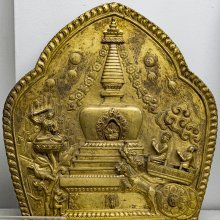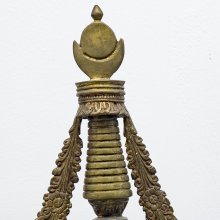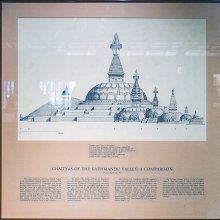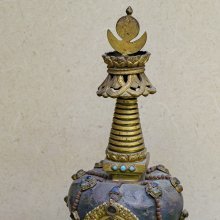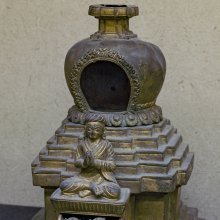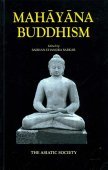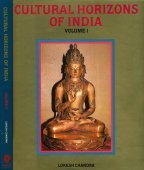Caitya, Chaitya: 24 definitions
Introduction:
Caitya means something in Buddhism, Pali, Hinduism, Sanskrit, Jainism, Prakrit, the history of ancient India, Hindi. If you want to know the exact meaning, history, etymology or English translation of this term then check out the descriptions on this page. Add your comment or reference to a book if you want to contribute to this summary article.
Caitya has 22 English definitions available.
Alternative spellings of this word include Caitya.
Images (photo gallery)
(+69 more images available)
Languages of India and abroad
Sanskrit dictionary
[Deutsch Wörterbuch]
Source: Cologne Digital Sanskrit Dictionaries: Böhtlingk and Roth Grosses Petersburger WörterbuchCaitya (चैत्य):—1. (von 5. cit oder 2. citi) m. die individuelle Seele [Bhāgavatapurāṇa 3, 26, 61. 70. 28, 28. 31, 19.]
--- OR ---
Caitya (चैत्य):—2. (von citā)
1) adj. was auf den Scheiterhaufen, auf das Grab Bezug hat u.s.w.: yūpa [ĀŚV. GṚHY. 3, 6.] [Gṛhyasaṃgrahapariśiṣṭa 2, 14.] —
2) m. n. Grabmal, Todtenmal; Tempel, Heiligthum; ein als Todtenmal dienender Feigenbaum u.s.w., ein an geheiligter Stätte stehender Feigenbaum u.s.w. (vgl. caityataru, druma, vṛkṣa). [ĀŚV. GṚHY. 1, 12.] [Yājñavalkya’s Gesetzbuch 2, 151. 228.] yatra yūpā maṇimayāścaityāścāpi hiraṇmayāḥ . śobhārthaṃ vihitāstatra na tu dṛṣṭāntataḥ kṛtāḥ .. [Mahābhārata 2, 69. 74.] caityayūpāṅkitā bhūmiḥ [1, 223.] akṛṣṭapacyā pṛthivī vibabhau caityamālinī [12, 914.] citacaityo mahātejāḥ [3, 10460.] alpāvaśeṣā pṛthivī caityairāsīt [10303.] āsīnaṃ caityamadhye [495.] sa caityo rājasiṃhasya saṃcitaḥ kuśalairdvijaiḥ . garuḍo rukmapakṣo vai triguṇo ṣṭādaśātmakaḥ .. [Rāmāyaṇa 1, 13, 30.] yebhyaḥ praṇamase putra caityeṣvāyataneṣu ca [2, 25, 4.] caityānyāyatanāni ca [56, 29.] sahasrapādamāsādya taccaityamadhirūḍhavān [5, 38, 25.] caityaprāsāda [27.] aśokavanikāyām apaśyadavidūrasthaṃ prāsādaṃ caityamuttamam . dhṛtaṃ stambhasahasreṇa [17, 20.] [Suśruta 1, 107, 19. 367, 1.] niviḍacaityabrahmaghoṣaiḥ [Mṛcchakaṭikā 159, 3.] [Rgva tch’er rol pa 28 u.s.w.] [Rājataraṅgiṇī 1, 103.] eko vṛkṣo hi yo grāme bhavetparṇaphalānvitaḥ . caityo bhavati nirjñātirarcanīyaḥ supūjitaḥ .. [Hiḍimbavadha 1, 40.] caityānāṃ sarvathā tyājyamapi pattrasya pātanam [Mahābhārata 12, 2637.] arcitaṃ sarvalokānāṃ saskandhaviṭapaṃ drumam . nāgahetoḥ suparṇena caityamunmūlitaṃ yathā .. [Rāmāyaṇa 4, 18, 23.] anekaśākhaścaityaśca nipapāta mahītale [Harivaṃśa 9876.] [Bhāgavatapurāṇa 4, 25, 16. 5, 24, 9.] Ueber den Unterschied zwischen caitya und stūpa bei den Buddhisten s. [Burnouf 74. 348. 630.] [Lassen’s Indische Alterthumskunde II, 266.] Nach den Lexicographen: n. = āyatana [Amarakoṣa 2, 2, 6.] [Trikāṇḍaśeṣa 3, 3, 311.] [Medinīkoṣa y. 21.] = devakulaṃ vinā mukham [Hārāvalī 198.] = citācūḍaka [Trikāṇḍaśeṣa 2, 8, 62.] = vihāra = jinasadman [Hemacandra’s Abhidhānacintāmaṇi 994.] = jinaukas (lies caityaṃ st. cityaṃ) und tadvimbam (Statue des Jina) [Hemacandra’s Anekārthasaṃgraha 2, 358.] = buddhavipra [Trikāṇḍaśeṣa 3, 3, 311.] = buddhavedya [Medinīkoṣa] Statt vipra und vedya ist wohl vimba zu lesen, welche Lesart der Verfasser des [Śabdakalpadruma] vor sich gehabt hat. Fälschlich macht er daraus zwei Bedeutungen (buddha und vimba) und lässt das Wort in diesen beiden Bedd. masc. sein. m. = devataru [Trikāṇḍaśeṣa 2, 4, 2.] = uddeśakavṛkṣa [3, 3, 311.] = uddeśyapādapa [Medinīkoṣa] = jinasabhātaru und uddeśavṛkṣa [Hemacandra’s Anekārthasaṃgraha] Vgl. grāmacaitya . —
3) m. Nomen proprium eines Berges (s. caityaka) [Mahābhārata 2, 814.]
--- OR ---
Caitya (चैत्य):—1. [SARVADARŚANAS. 20, 9. fg.]
--- OR ---
Caitya (चैत्य):—2.
2) śākyādipraṇītacaityavandana [Oxforder Handschriften 264,a,30.]
Source: Cologne Digital Sanskrit Dictionaries: Sanskrit-Wörterbuch in kürzerer FassungCaitya (चैत्य):—1. m. die individuelle Seele.
--- OR ---
Caitya (चैत्य):—2. —
1) auf den Scheiterhaufen — , auf das Grab Bezug habend. —
2) m. n. Grabmal , Todtenmal ; Tempel , Heiligthum ein als Todtenmal dienender Feigenbaum u.s.w. ein an geheiligter Stätte stehender Feigenbaum u.s.w. caityārtham so v.a. als Object der Verehrung , als Reliquie [Lalitavistarapurāṇa 336,16.337,7.] —
3) m. Nomen proprium eines Berges.
Sanskrit, also spelled संस्कृतम् (saṃskṛtam), is an ancient language of India commonly seen as the grandmother of the Indo-European language family (even English!). Closely allied with Prakrit and Pali, Sanskrit is more exhaustive in both grammar and terms and has the most extensive collection of literature in the world, greatly surpassing its sister-languages Greek and Latin.
See also (Relevant definitions)
Starts with (+6): Caitya-patta, Caitya-shaila, Caityabhuta, Caityadru, Caityadruma, Caityageha, Caityagni, Caityagriha, Caityaka, Caityaka-shaila, Caityalaya, Caityamandira, Caityamukha, Caityapala, Caityaparipati, Caityapurusha, Caityasailah, Caityasthana, Caityataru, Caityavandana.
Ends with: Buddha-caitya, Dharmadevacaitya, Gramacaitya, Jinacaitya, Keshacaitya, Lalitacaitya, Mahacaitya, Munirajacaitya, Nirvana-caitya, Siddhacaitya.
Full-text (+377): Caityavriksha, Caityadruma, Caityamukha, Caityapala, Kashayagrahana, Caityadru, Cetta, Lalitacaitya, Chandakanivartana, Cudapratigrahana, Caityataru, Ceia, Keshacaitya, Caitya-shaila, Vandaka, Caityayajna, Caitika, Capala, Saptamra, Caityagriha.
Relevant text
Search found 82 books and stories containing Caitya, Chaitya; (plurals include: Caityas, Chaityas). You can also click to the full overview containing English textual excerpts. Below are direct links for the most relevant articles:
Vastu-shastra (1): Canons of Architecture (by D. N. Shukla)
(vi) Rise of Art < [Chapter 4 - An outline History of Hindu Architecture]
(v,2) Vāstu in Epic literature < [Chapter 4 - An outline History of Hindu Architecture]
(v,3) Vāstu in Buddhist Literature (Jātakas and Pali Canons) < [Chapter 4 - An outline History of Hindu Architecture]
Amaravati Art in the Context of Andhra Archaeology (by Sreyashi Ray chowdhuri)
Lower Kṛṣṇā Valley (11): Gunṭupalli < [Chapter 2 - Amarāvatī and other Archaeological Sites of Ancient Andhra Pradesh]
The rule of the Sātavāhanas < [Chapter 4 - Survival of Amarāvatī in the Context of Andhra Art]
Lower Kṛṣṇā Valley (30): Chejarla < [Chapter 2 - Amarāvatī and other Archaeological Sites of Ancient Andhra Pradesh]
Amarakoshodghatana of Kshirasvamin (study) (by A. Yamuna Devi)
Town Planning (4): Other Constructions < [Chapter 3 - Social Aspects]
Town Planning (1): City < [Chapter 3 - Social Aspects]
Nagarjunikonda < [April 1955]
Buddhist Vestiges of Andhradesa < [July – September, 1994]
Glimpses of Ancient India < [January – March, 2001]
Sripura (Archaeological Survey) (by Bikash Chandra Pradhan)
Vaisnava Temples (1): Laksmana Temple < [Chapter 2 - The Architectural Panorama]
Jaina Vihara < [Chapter 2 - The Architectural Panorama]
Vastu-shastra (5): Temple Architecture (by D. N. Shukla)
Stūpas (Shrines for Devotion) < [Chapter 12 - History of Hindu Temples (Prāsādas and Vimānas)]
Chapter 1 - Denotation of the term ‘prāsāda’—the hindu temple
Guhādharas (Buddhist rock-cut architecture) < [Chapter 12 - History of Hindu Temples (Prāsādas and Vimānas)]
Related products

